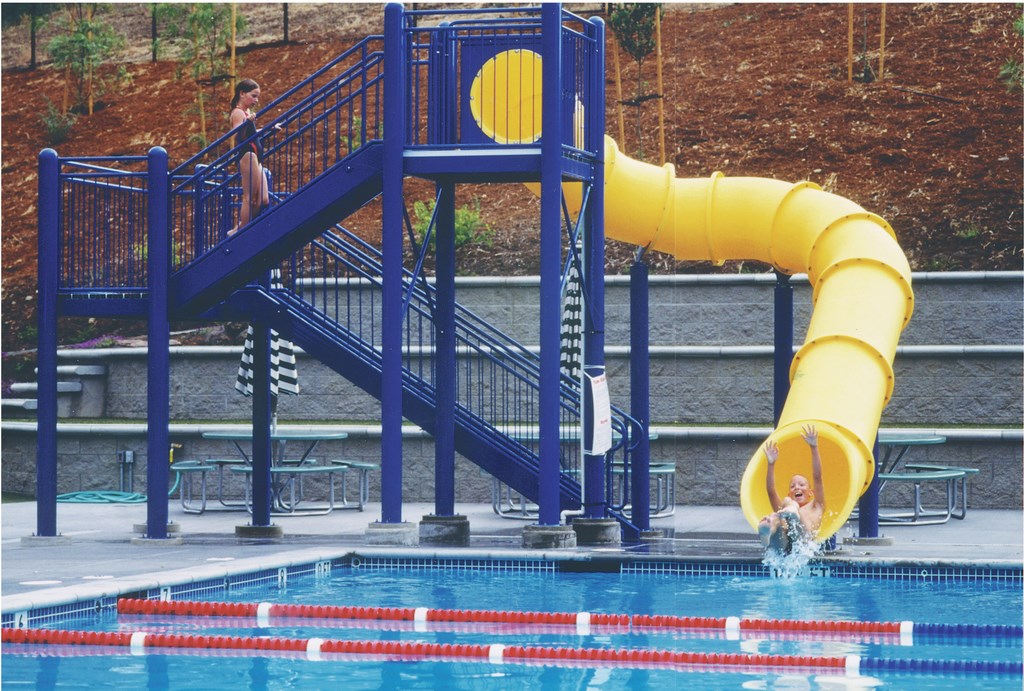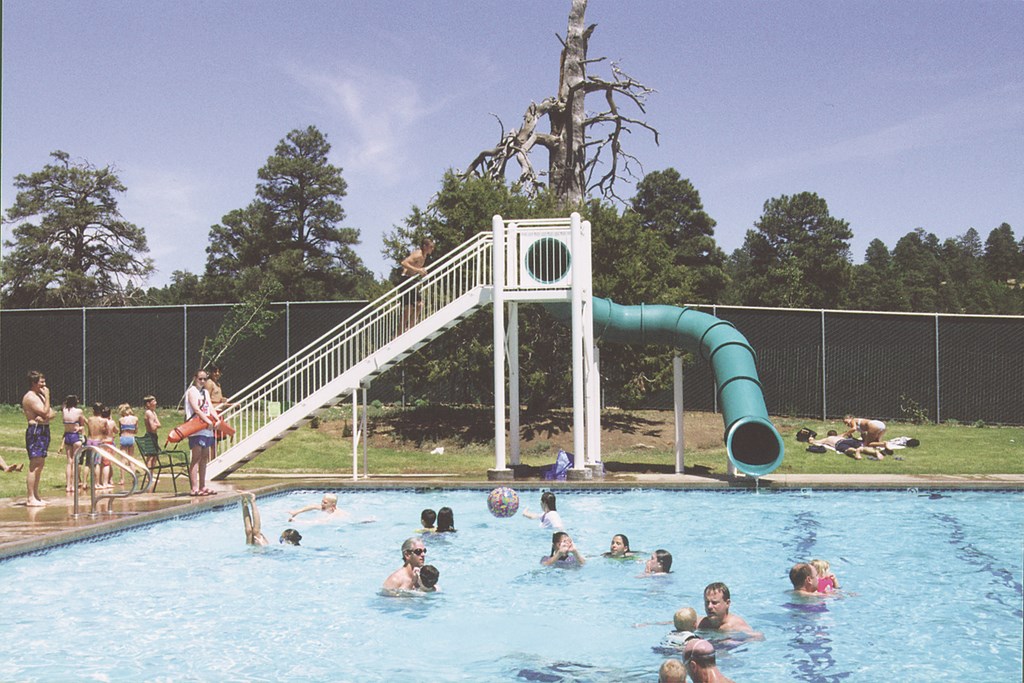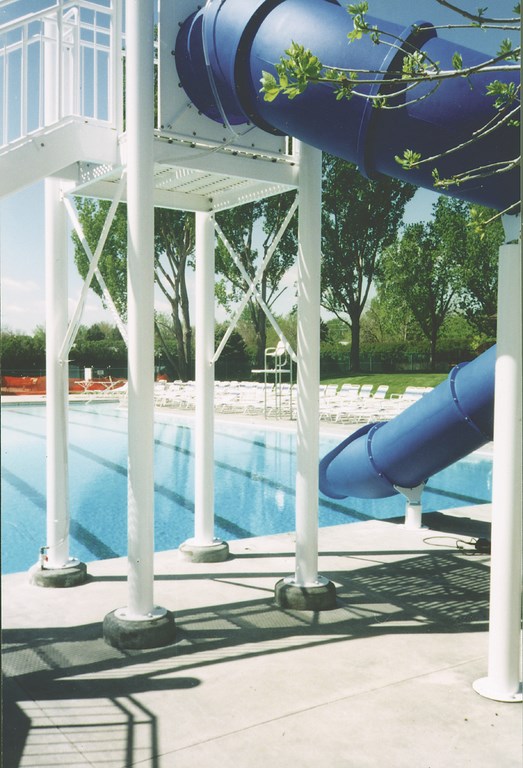Splash Factors

When today’s kids show up at a municipal swimming pool for a day of fun and excitement, they’re not looking to swim laps.
To be sure, the standard for what can be called “aquatic fun” has been set pretty high in recent years by huge water theme parks, with their wave pools and whitewater rides and huge, twisting, open-flume slides. Nowadays, older “flat-water pools” just can’t compete for summertime attention among active, thrill-seeking children – except in one arena.
Indeed, the availability these days of affordable waterslides has changed the competitive picture for traditional public and semi-public swimming pools. Each year, scores of these facilities are being retrofitted with slides that have led to a strong revival in community interest and family attendance.
This strategy has worked for one simple reason: From top to bottom, slides are great fun!
THE FUN FACTOR
Time and time again, you’ll see kids take a quick ride down a slide, splash down with arms and legs flying – and climb right back up the stairs for another run – repeating the cycle for hours on end only to protest like mad when Mom and/or Dad says it’s time to go.
Quiet waters that were once used almost exclusively for lap swimming and lifeguard training are now being reclaimed by kids eager to take their next ride.
The small community pools where this new phenomenon has taken hold couldn’t have been retrofitted to include wave basins or raft rides, but they’re just right for the small, semi-portable to the medium-sized, deck-mounted tube waterslides of the sorts made by our company, Aquatic & Site Technologies of Portland, Ore., and several others. In fact, the concept has caught on so well that even some residential projects now feature these slides as key parts of their fun-oriented designs.
| Indoors or out, closed-flume slides are a magnet for children of all ages – just the ticket for community pools seeking to compete with local waterparks without breaking their budgets. |
As suppliers, we’re happy with this evolution and are looking for more and more ways to work with clients who are looking to add a whole new “play dimension” to the swimming-pool experience. We’re witnessing the reinvention of the community plunge and development of a whole new low-cost definition for pool-related fun.
The low-cost factor is important: Few municipalities or commercial complexes these days can afford upgrades of the sort they might see as necessary to compete with waterparks, whose big, elaborate slides can easily cost much more than $100,000. There are several manufacturers providing affordable slides that fit the budget and, as important, the physical scale of most swimming pool facilities.
As the photographs accompanying this text show, these slides aren’t to be confused with the small fiberglass slides popularized on residential pools in the 60s: What we’re talking about here are closed-flume slides built to the highest public-safety standards – the kind you find in waterparks, only smaller.
Waterparks use their big, serpentine slides as billboards: They announce what’s going on inside the park to anyone within eyeshot. The same phenomenon can be (and has been) put to work for community pools. Big, primary-colored slides are a magnet to families and a great way to attract members of the community to all of the benefits that come with swimming and playing in water.
SMALLER SCALE
The slides available for community-pool applications are typically smaller than those you find at a waterpark, where runs often stretch out for more than 100 feet and the structural footprints can take up the best part of an acre of land.
To accommodate that sort of mass-scale installation, the slide almost certainly has to be part of the facility from the planning stage forward. By contrast, the smaller-scale slides now available are designed for retrofitting as well as original construction; ours, for example, feature runs from 50 feet all the way down to a modest 8 feet and have been installed in waterparks – but we’ve found that the market for our products is much, much broader than that.
| The vivid colors available with these slides and structures serve to brighten the aquatic setting – and help a public or semi-public pool boldly promote the fact that it’s as much about fun as it is about exercise. |
Our tallest structure tops out at 18 feet high; water depths from three to five feet are required, depending on the size of the slide and the angle of entry to the water out of the end of the 27-inch-diameter tubes. The tubes are made with low-density polyethylene (LDPE) and are manufactured in three- or four-foot lengths in a variety of curves and radiuses that enable us to create a range of twisting configurations. The supports are made of PVC-coated steel piping, as are the platforms, steps, barriers and handrails.
The key to acceptance of these products is that they can fit in relatively small spaces. Most of these small slides require just ten feet of deck space from the edge, with an additional minimum of five feet of clearance for foot traffic around the structure – over areas stretching in length from 15-30 feet.
| The support systems for these slides are designed for simplicity. Indeed, some of the smaller models can be mounted with conventional deck anchors or are even semi-portable. For some of the larger slides, such as the one seen here, the final appearance of the substructure can be elegant – on a relatively small footprint! |
Construction is smaller scale, too. They’re modular, so all that’s required is bolting them together in the proper sequence. The smallest slides are simply affixed to the deck using common concrete deck anchors. For bigger models, the upright supports for platforms mounted at ten feet or higher sit atop 15-inch piers made with sonotubes, while small piers are constructed as tube supports and are anchored to the deck.
Plumbing is simple as well. The slides require a water flow of less than 20 gallons per minute – enough to wet the surface. This contrasts sharply with larger, open-flume-type structures, for which a tremendous amount of flow is needed literally to flush the bather down the slide. In our smaller-scale systems, gravity does most of the work.
The water for the slide is usually tied right into the pool’s existing return system, with very little effect on pump performance. And when a separate pump is used, a fractional horsepower pump is usually all that’s required to deliver water to the top of the slide via a flexible 3/8-inch line.
THE TRUE TEST
The fact that these slide systems are easy on the budget and easy to install is great, but the most important factor from the operator’s perspective is what they do for attendance.
Bigger kids love the fast action, thrills and physical exertion they find with the larger closed-flume slides, while families with younger children flock to the parts of the pool set up with smaller slides. And this is real “family value,” because community pools and YMCAs generally charge just nominal fees for all-day use compared to the $15 to $30 charged for admission to waterparks.
|
Aesthetic Equations Through the years, pool slides have been tagged as unsightly, intrusive and downright ugly. Even those of us in the trade are willing to agree from time to time that our massive serpentine structures and metal rigging offer their share of aesthetic challenges, and the fact that designs are always becoming sleeker and more streamlined indicates our own sensitivity to the issue and desire to deliver the whole design package, beauty included. Be that as it may, we comfort ourselves with the thought that any slide is beautiful when you factor in the sheer joy it can bring to kids and the economic benefits it delivers to a community aquatic facility. — J.S. |
Parents appreciate the price break and are aware as well that slide use is constantly supervised by at least one lifeguard – and often two. As long as safety signs are posted and a few basic rules are followed (including our prime directive – slide only on your back, feet first), injuries are avoided.
Naturally, safety is a huge concern for slide manufacturers. From the angle of the stairs or the spacing of barrier pickets to the dual-level handrails or the non-skid surface of the steps, every aspect of these slides is designed with safety in mind. And suppliers work with clients to make certain slides are placed suitably in relation to the movement of people in and out of the pool and around the slide structure to ensure safety and convenience.
For operators, the main outcome of slide installation drops right to the bottom line, through increased attendance. And those who’ve installed these slides often point out that not only do more people crank through the turnstiles, but they also tend to stay longer. The result is increased concession sales and a quicker-than-expected return on the slide investment.
Ultimately, however, we always look beyond the fiscal benefits to the outcome that makes us happiest and proudest as slide manufacturers: Our products attract people to the water, and that’s good for all aquatic sports and activities.
John Stupfel is founder and president of Aquatic & Site Technologies, a manufacturer of tube waterslides in Portland, Ore. He established the firm in 1995 with a focus on manufacturing affordable and safe waterslides for a variety of commercial, municipal and residential swimming pool operators and owners. Before entering the watershaping trade, Stupfel was group vice president of administration for a diversified holding company in Portland.














